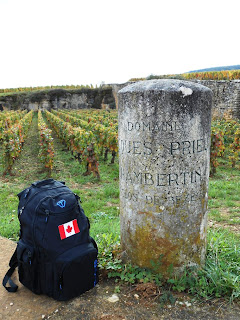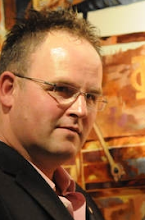On a recent trip to Burgundy in France I found myself on a voyage of both exploration and reflection. My
need to understand this complex wine region extends well beyond what others
have written or what my own tasting notes reflect. In order to explain
the complexity of Burgundy to enthusiastic newcomers, one must stand at the
foot of these great vineyards and stare upon the contour of the land, watch the
clouds as they form over the tree-topped hills, and touch the stone-walled
cellars that have held bottles for centuries of passing vintages. The trip was
truly an enlightenment of wine fascination and as a friend pointed out after
the fact, a pilgrimage.
I enjoy wine from every grape growing region in the world, some more than
others but I also appreciate the variations in aroma, body, and taste that each
country and region has to offer. Occasionally that difference is rather
blatant, other times less so, but in every example it is (or should be) unique.
This constant variable is what has kept me motivated. If all wines were
to taste the same, I'd likely drink something else - or figure out how to make
my own.
 The region that I continually gravitate toward is the Côte d'Or in
The region that I continually gravitate toward is the Côte d'Or in
For the same reason that people are drawn to the mysteries of Stonehenge, China's Great Wall , or Easter Island in the south Pacific, I was looking for
answers to a number of questions: What is it that makes this place unique? Could
it just be a gross exaggeration as a result of perception? Why should I
or anyone else pay such a premium to enjoy it?
I found the answers that I was looking for plus a few more along the way and
I'd like to share my thoughts and observations with you over the next couple of posts.
Thinking back to a little over a decade ago, I too was discouraged by Burgundy 's complex label
language, classification system, and degree of vintage variation. The
region is a double-edged sword of sorts; to the serious wine enthusiast it might
represents vinous perfection, but as a new comer, the labels are next to
impossible to understand and if you dare to 'cheap-out' on your purchase,
disappointment is certain. Unfortunately that disappointment often leads
to discouragement which in terms of wine selection tends to guide people back
to the path of least resistance i.e. Australia ,
California , and the slopes of South America .
So why bother? In my case, the need to explore the unknown will always
demand immediate attention. Your attraction to this place and its wine
may be entirely different.
My first experience with Burgundy
was highly atypical, somewhat lucky, and extremely positive; it involved a
bottle of 1999 Vosne-Romanée. The bottle, while seemingly
impressive, was an impulse buy while out of town. The luck factor is that
there is no (or should not be any) bad wine made in the village of Vosne Romanée Burgundy is to know not
only the village and vintage, but also the vineyard if applicable, and more
importantly the producer or domaine that has made the wine. After serving
the 1999 Domaine Misset, Vosne-Romanée les Barreaux as an alternative to the richer and more
full-bodied styles of Shiraz and Amarone that normally accompany dinner at our home, the Burgundy created a
bizarre moment of silence in the room. Each person at the table
simultaneously stopped, took a moment to stare at their glass, and then asked
what it was that we were drinking and where it was from.
Beyond "It's Pinot Noir from Burgundy ."
I really didn't have an answer for them. The catch, however, is that it
took me numerous attempts, multiple bottles, and hundreds of dollars to come
even remotely close to recreating that sense of awe. Now in my world,
this is the recipe for fascination and it has lead me on a continual search for that 'perfect bottle'.
The blunt truth is that most people will not take the time to understand this
and I cannot overemphasis how critically important that is for the rest of us; Burgundy is not
mass-produced. There is by no means enough of it for everyone. In fact, I cringe at the thought of finding a bottle of premier cru Chambolle-Musigny on the wine list at The
Keg or on the store shelf at Costco in the States. These places sell
fruit-bombs to people who rarely step outside the scope of beverage mediocrity. A bottle of fine Burgundy in this environment would be tragically lost.
The supply of Burgundy
is restricted by the structure of the vineyard classification system and
resultant land on which the vines were planted long ago. Its complexity and
rarity are also what make it appealing to those who desire to know and are
willing to spend a little more.
 The name Côte d'Or is a reflection of the changing autumn leaves that catch the
morning sun on the hills that rise to the west - I saw it, and yes, it is truly
breathtaking, though I do find myself wondering if the golden slope more
accurately relates to the money these vines have generated for the Church over
the last 1000 years. The production and sale of wine in
The name Côte d'Or is a reflection of the changing autumn leaves that catch the
morning sun on the hills that rise to the west - I saw it, and yes, it is truly
breathtaking, though I do find myself wondering if the golden slope more
accurately relates to the money these vines have generated for the Church over
the last 1000 years. The production and sale of wine in
In modern times, the supply versus demand placed on Burgundy by the western world and now a new
Asian market is unfortunately what continues to drive the price from marginally
affordable to totally unreasonable. Along a 45km stretch of road
extending between Dijon
to the north and Santenay in the hills to the south you will find the most
expensive farmland in the world. At the upper end of the quality
spectrum, the bottled wine reflects not only the spirit of the land, but its
value as well.
In my next post, I invite you to walk with me from Fixin to Morey-Saint-Denis, stopping
to tasting along the way.
~> Burgundy Part Two
~> Burgundy Part Two




This comment has been removed by the author.
ReplyDelete